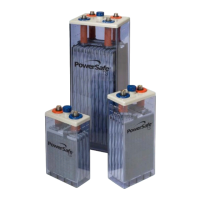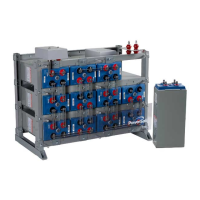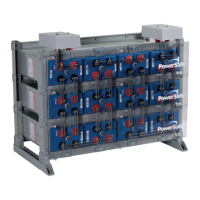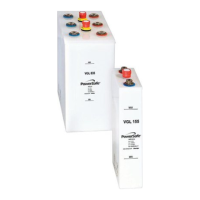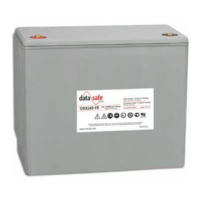h) if the battery is to be immediately put into service, continue the
commissioning charge for a minimum total continuous time of 72 hours.
I) if the battery is to be subjected to a site acceptance test before being put
into service, continue the commissioning charge for a minimum total
continuous time of 144 hours.
N.B. when a site acceptance test is required, it must be completed following
the commissioning charge BEFORE any operating load is introduced into the
system.
Upon completion of the commissioning charge or recharge following a site
acceptance test, the load circuit may be introduced into the system and the
battery maintained thereafter in the normal operating “float charge” mode.
10. Charger Selection
These batteries are designed to be connected in parallel with a load that is
normally powered by a charger. The charger MUST be of the constant
potential type with a characteristic to give an applied charging voltage, at the
main battery terminals, equivalent to a minimum of 2.25 volts per cell and a
maximum 2.28 volts per cell at an ambient temperature of 25°C (77°F). For
further details of the float voltage to be applied to those installations where the
mean operating temperature is other than 25°C (77°F), consult Appendix “A”.
For optimum charge efficiency the MAXIMUM charge current available to the
battery should be limited to 8% C
8 capacity expressed in amps eg 80.64 amps
for the VM-1000, 124.80 amps for the VM-1500, with a MINIMUM charge
current output equivalent to 5% C8 capacity expressed in amps eg 50.4 amps
for the VM-1000. 78 amps for the VM -1500.
The battery will accept, without damage, higher values of charge current
provided that the applied charge voltage does not exceed the recommended
float charge level.
The ripple content of the charging current affects the life of a battery. The rms
value of the a.c. component of the charging current (fundamental and
harmonic) must not exceed 0.10 C
8 (Amps).
Transient and other ripple type voltage excursions can be accommodated
provided that, with the battery disconnected, the system peak to peak voltage
including regulation limits falls within ±2.5% of the recommended float
voltage.
11. Routine Operation
11.1 Charging
The normal operating procedure is for the battery to be subject to a “float
charge” in parallel with the charger as described above.
It is important that the level of the applied voltage is adjusted in accordance
with the value(s) given in Appendix “A”. Select a temperature that most nearly
represents the actual mean operating temperature of the particular installation
in order to optimise the battery performance.
It is important that the applied voltage does not fall below the minimum value
shown.
Equally, any excursion of “battery voltage” above the recommended float
charge voltage for more than one minute should either trigger an alarm or
cause immediate termination of the charge (except under controlled elevated
voltage charging, see 11.2).
It is recommended that batteries should be recharged within 24 hours
following a discharge.
It is recommended that this level of float voltage also be used for:
a) the freshening charge procedure - see Section 5,
b) the commissioning charge procedure - see Section 9
c) for the normal recharging of the battery following a discharge in order to
minimise any possibility of overcharge.
11.2 Faster Charging
Recharge times can be reduced by increasing the level of the applied charging
voltage.
The MAXIMUM applied voltage should never exceed that equivalent to 2.4
volts per cell at 25°C (77°F) AND when using this charge regime:
a) reduced service life will result from frequent use.
b) the available charging current MUST be limited to 8% C
8 capacity
expressed in amps.
c) the charge MUST be terminated when the charge current reaches a
constant value.
d) this elevated applied charging voltage may be used for a MAXIMUM of 12
hours.
IF THIS METHOD IS SELECTED IT IS VITAL THAT THE CHARGER IS RE-SET TO
THE “NORMAL” FLOAT VOLTAGE SETTING AT THE END OF USE TO AVOID
SERIOUS DAMAGE TO THE BATTERY.
11.3 Discharging
The minimum average voltage per cell should not be reduced to below 1.60V
for longer than 2 minutes on a battery designed for a standby time of up to 1
hour or for longer than 5 minutes on a battery designed for a standby time in
excess of one hour. It is recommended that a low voltage disconnect feature is
included in the system to ensure compliance with the above.
N.B. momentary dips in voltage below 1.6Vpc as experienced in switchgear
closing operations are not detrimental.
11.4 Operating Temperature
The nominal operating temperature for a lead acid battery is
20-25°C (68-77°F) Operating at temperatures above 25°C (77°F) will reduce the
operating life of a battery.
12. Routine Maintenance Procedures
12.1 Three Monthly Inspection.
a) complete a visual check of the overall installation looking for signs of
electrolyte leakage and corrosion around the terminal posts.
b) check and record the overall applied voltage across the battery and adjust
as necessary.
c) record the individual cell voltages on the battery record sheet under float
charge and compare them with the last set looking for any adverse trends
in the reading of any individual cell(s).
12.2 Six Monthly Inspection
a) repeat the three monthly inspection.
b) if any cell is continuing to show adverse trends in it’s voltage reading
contact your EnerSys
®
representative.
7
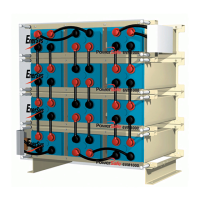
